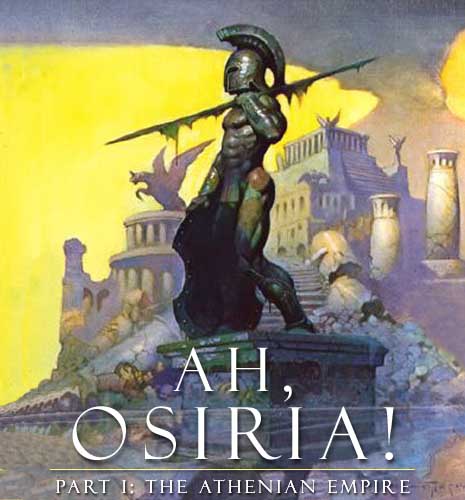
Editorial
|
Press Releases
|
Book Reviews
|
Fragments
Serpent Mound I
|
Giants I
|
Osiria I
Register
for our new Hall of Records Newsletter!
Questions? Comments? Suggestions? Advertising? Press Releases?
Contact us!
Part II: Antediluvian Egypt
|
Part III: Nimrod Hunting
|
Part IV: The Beast from the Sea
Ah, Osiria! Discussion Board
(Requires Registration)
The Land of Osiris
|
Malta: Capitol of Osiria?
|
The Athenian Empire
|
The Search for Osiris
Osiria Links
|
Osiria Books
|
Osiria Audio
|
Osiria DVD
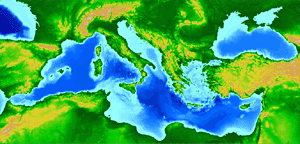
The Mediterranean Sea is an intercontinental sea situated between Europe to the north, and Africa to the south. It covers an area of about 970,000 square miles, with an average depth of 4,500 feet and a maximum depth of 15,000 feet off the southern coast of Greece. The Mediterranean is an almost completely closed basin where the continuous inflow of surface water from the Atlantic Ocean is the sea's major source of replenishment and water renewal, giving it a high degree of salinity. It is estimated waters take over a century to be completely renewed through the Strait of Gibraltar wich is only 1,000 feet deep. Ancient Osiria, much of which is now submerged, stretched from southern Europe to North Africa, and from the ancient Near East to the Pillars of Hercules.
Image and text adapted from
Universit� degli Studi di Pavia.
|
 h, Osiria! Ancient enemy of Atlantis, saviour of Europe and Africa, and all who dwelt between the pillars! Once the fertile breadbasket of the world, now sunken beneath thousands of feet of saltwater in the same cataclysm that destroyed
Atlantis
and the rest of
the antediluvian world.
h, Osiria! Ancient enemy of Atlantis, saviour of Europe and Africa, and all who dwelt between the pillars! Once the fertile breadbasket of the world, now sunken beneath thousands of feet of saltwater in the same cataclysm that destroyed
Atlantis
and the rest of
the antediluvian world.
You will not find Osiria on any map, nor will you find it in biblical or even most historical literature. Osiria was, like Atlantis, a theoretical empire that happens to fit the facts, whose name has been derived from one of the most ancient gods of the region of the Mediterranean — Osiris.

David Hatcher Childress
has popularized the theory that the Mediterranean Basin was once the site of a vast, fertile region that formed the heart of what some esoteric literature refers to as "the Osirian Empire", an empire that was destroyed by the same Great Flood that destroyed Atlantis and the rest of the antediluvian world. The megalithic remains of this once powerful empire now lay scattered all across the Mediterranean, with numerous megalithic structures remaining not only on islands and on its shorelines, but also deep under its waters — over 200 underwater structures, according to Childress.1 These structures were called megalithic, literally, "big stones", due to the fact that the blocks used in their construction were of a huge size relative to building blocks that have been used during recorded history — so huge and so heavy, in fact, that modern engineers today still do not know how they were moved and set into place so precisely. The origin of these megalithic structures as yet remains a mystery, as they appear to date back from a time in mankind's distant past that has been all but forgotten. As Childress explains,
The Osirian Civilization, according to esoteric tradition, was an advanced civilization contemporary with Atlantis. In the world of about 15,000 years ago, there were a number of highly developed and sophisticated civilizations on our planet, each said to have a high degree of technology. Among these fabled civilizations was Atlantis, while another highly developed civilization existed in India. This civilization is often called the Rama Empire.
What is theorized is a past quite different from that which we have learned in school. It is a past with magnificent cities, ancient roads and trade routes, busy ports and adventurous traders and mariners. Much of the ancient world was civilized, and such areas of the world as ancient India, China, Peru, Mexico and Osiris were thriving commercial centers with many important cities. Many of these cities are permanently lost forever, but others have been or will be discovered!
It is said that at the time of Atlantis and Rama, the Mediterranean was a large and fertile valley, rather than a sea as it is today. The Nile River came out of Africa, as it does today, and was called the River Styx. However, instead of flowing into the Mediterranean Sea at the Nile Delta in northern Egypt, it continued into the valley, and then turned westward to flow into a series of lakes, to the south of Crete. The river flowed out between Malta and Sicily, south of Sardinia and then into the Atlantic at Gibraltar (the Pillars of Hercules). This huge, fertile valley, along with the Sahara (then a vast, fertile plain), was known in ancient times as the Osirian Civilization.2

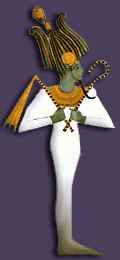
|
The namesake and founder of the Osirian Empire was the Egyptian god
Osiris.
In the Egyptian pantheon, Osiris was the son of the gods
Nut,
goddess of the sky, and
Geb,
god of Earth. Osiris was married to
Isis, with whom he fathered the falcon-headed god
Horus.
Osiris was also brother to
Nepthys, Egyptian goddess of the dead, and
Set,
Egyptian god of chaos and disorder.
The name "Osiris" has an interesting history. The name as we know it today is actually a Greek corruption of the Egyptian word "Asar", or "Usar", which can mean "the Strength of the Eye", or "He Who Sees the Throne". These translations are based upon the fact that the hieroglyphic name for Osiris includes a throne and an eye, as well as the hieroglyph for "god", though there are at least 158 known versions of the name.3
Osiris was an unusual god with a mysterious origin, the exact meaning of his name also being a source of controversy: "From the hieroglyphic texts of all periods of the dynastic history of Egypt we learn that the god of the dead, par excellence, was the god whom the Egyptians called by a name which was commonly known to us as 'Osiris'. The oldest and simplest form of the name is written by means of two hieroglyphics, the first of which represents a 'throne' and the other an 'eye', but the exact meaning attached to the combination of the two pictures by those who first used them to express the name of the god, and the signification of the name in the minds of those who invented it cannot be said."4
Osiris was at one time one of the most popular gods of the entire Mediterranean region, as he was seen as a great "civilizer" of mankind. In the myths, Osiris brought mankind knowledge and technology that allowed the barbaric early peoples to develop civilization. Moreover, the fact that he was believed to have "conquered death" made his story popular first among ruling aristocracies, and later among people of all classes, as they too wished to be resurrected, and live forever. As McDevitt explains,
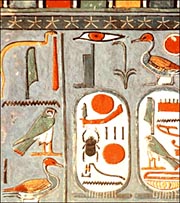
|
|
A fragment of hieroglyphic writing showing a variation of the name of Osiris. For the ancient Egyptians, the main purpose for writing was not decorative, and it was not originally intended for literary or commercial use. Its most important function was to provide a means by which certain concepts or events could be brought into existence. The Egyptians believed that if something were committed to writing it could be repeatedly 'made to happen' by means of magic. Osiris' hieroglyph, the eye over the throne, usually accompanied by the "god" hieroglyph to indicate deity, is portrayed here with a plant instead, indicating Osiris in his fertility aspect. Image and text from
"The Cosmetic Hieroglyph"
by Jeremy Lemmon.
|
The oldest religious texts refer to Osiris as the great god of the dead, and throughout these texts it is assumed that the reader will understand that he once possessed human form and lived on earth. As the first son of Geb, the original king of Egypt, Osiris inherited the throne when Geb abdicated. At this time the Egyptians were barbarous cannibals and uncivilized. Osiris saw this and was greatly disturbed. Therefore, he went out among the people and taught them what to eat, the art of agriculture, how to worship the gods, and gave them laws. Thoth helped him in many ways by inventing the arts and sciences and giving names to things. Osiris was Egypt's greatest king who ruled through kindness and persuasion. Having civilized Egypt, Osiris traveled to other lands, leaving Isis as his regent, to teach other peoples what he taught the Egyptians.
During Osiris' absence, Isis was troubled with Seth's plotting to acquire both her and the throne of Egypt. Shortly after Osiris' return to Egypt, in the twenty-eighth year of his reign, on the seventeenth day of the month of Hathor (late September or November), Seth and 72 conspirators murdered him. They then threw the coffin in which he was murdered into the Nile, with his divine body still inside.
Isis, with the help of her sister Nephthys, and Anubis and Thoth, magically located Osiris' body. Upon learning the his brother's body was found, Seth went to it and tore it into fourteen pieces and scattered them throughout Egypt. Isis once again found every part of his body, save his phallus (it had been eaten by the now-cursed Nile fish). She magically re-assembled Osiris and resurrected him long enough to be impregnated by him so that she could give birth to the new king Horus.5
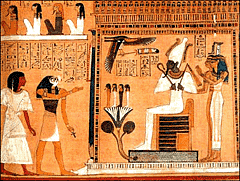
|
A fragment from the
Egyptian book of the Dead,
showing Osiris on the throne, surrounded by Isis, Nepthys, and Horus. Osiris was considered the judge of the dead, deciding who proceeds into everlasting life, or everlasting damnation. Isis and Nephthys aided in this judgement.
Image from
"The Cosmetic Hieroglyph".
|
Osiris was unique among the gods of Egypt in that the Egyptians believed that he had once been an ancient, human ruler of predynastic Egypt who had died and had become the ruler of the dead in the afterlife. Moreover, it was believed that he would be
resurrected
and return again at the
end of days
to rule the world.6
As a result, the funerary cults of Egypt emulated the story of Osiris in their rituals so as to magically give the dead eternal life in the next world, and the hope of resurrection at the end of days. Osiris also took on the aspects of a nature and fertility god, as it was believed that he was the numinous power behind the fertility of the land, of the crops that arose from the dead every year just as Osiris had. As Ward explains, "Legendary ruler of predynastic Egypt and god of the underworld, Osiris symbolized the creative forces of nature and the imperishability of life. Called the great benefactor of humanity, he brought to the people knowledge of agriculture and civilization. The worship of Osiris, one of the great cults of ancient Egypt, gradually spread throughout the Mediterranean world and, with that of Isis and Horus, was especially vital during the Roman Empire."7
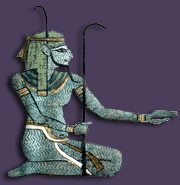
|
Nun, the god of the primordial waters. Nun existed from the beginning, and was the source from which the Egyptians gods came forth.
Nun probably represents the waters of the Great Flood, which covered the entire Earth. The coffin in the myth of Osiris might represent
Noah's ark, and Osiris might be Ham, the ancestor of the Egyptians (or perhaps one of his descendants) who was "resurrected"
from the waters after he exited the ark.
Image from
Ancient Egypt: The Mythology.
|
The "dying and reviving god" motif that was popular throughout the ancient world had its roots in Egypt, in the worship of the god Osiris. Osiris, the "great architect" of human civilization, came to be the preeminent god not only of Egypt, but famous around the Mediterranean world, including the
ancient Near East.
It may be, however, that the original "Osiris" was not born in historic times, but in the antediluvian world, and that the "resurrection" of Osiris might actually be a description of the return of the ancient mystery religion — the "mystery of iniquity" — from the world before the Flood. A truth encapsulated in myth, the story of Osiris might actually be the story of a real king who, some time after the Flood, had begun to uncover the old secrets that the Flood had sought to destroy. Perhaps the wooden "coffin" of the Osirian myth was actually what the Bible refers to as "Noah's ark", and Osiris was actually Ham, the ancestral father of the Egyptians — or perhaps his wicked son Canaan, or even
Amor,
father of the Amorites.
This would explain why the most ancient god of the Egyptians was
Nun,
who is described as the god of the primordial waters from which all other gods came forth. Nun, who was described as an endless, calm sea, may represent the world as it was covered with the floodwaters from which their ancient ancestor, Ham, was "resurrected" via the ark. Later, as Ham's descendants multiplied, they sought to recreate the world as it was before the Flood, actively seeking for the ancient wisdom that had been lost. And from this search, the myth of Osiris was born — full of clues that initiates were meant to use to help them recover the ancient secrets from the world before the Flood.
Childress believes that the story of Osiris' death at Set's hands and the cutting up of Osiris' body into exactly 14 parts might have been a clue as to what happened to the ancient empire of Osiria as a result of the Flood: "There are many important themes in the legend of Osiris, including resurrection and the vanquishing of evil by good, and perhaps a key to the ancient Osirian civilization. Were the 14 pieces of Osiris the 14 vestiges of the now flooded land?"8 Though the antediluvian world was destroyed, pieces of it remained — 14 pieces, according to the myth. And an understanding of these "14 pieces" may be the clues necessary to lead us to understanding both Osiris the man, and Osiris the empire. In this four-part series on ancient Osiria, we will cover four major known pieces of the ancient puzzle, starting with Malta — home of the oldest megalithic structures in the world.


|
|
Hagar Qim, one of the more spectacular megalithic temples that dot Malta and the nearby island of Gozo. Hagar Qim,
Though not the oldest, is one of the best preserved temple structures to be found on the islands, where several statues
of the famous
"fat lady"
were discovered when the site was excavated around 1850. Image from
Heritage Malta.
|
The island of Malta lies in the center of the Mediterranean Sea some 80 miles south of Sicily. Malta, a tiny island only 14 miles long by 8 miles wide, has over a dozen major archaeological sites and a colorful history stretching back many thousands of years, making it the most historically rich country on the planet, per square foot. More importantly to our study, Malta's ruins, located in the dead center of the theoretical Osirian Empire, are the oldest known man-made structures on Earth. Malta's location, the number and size of the megalithic structures to be found all over the island, the level of importance the structures apparently held, and the extreme age of the structures make Malta a likely candidate for the ancient capitol of the now submerged Osirian Empire.
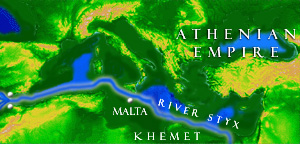
The Osirian "Empire" actually made up of a series of allied nations including Athens, Khemet (Egypt), and other nations alluded to
but not named by Plato. In the world before the Flood, but the deepest parts of the Mediterranean basin comprised extremely rich,
fertile soil, which must have yielded a tremendous amount of produce. The deepest parts of what is now the Mediterranean were then
deep, freshwater lakes that served as tributaries to the River Styx. The Styx began its life as what is now known as the River Nile,
and then turned west, passing between Sicily and Malta, then south of Sardinia, and then through the Pillars of Hercules to form the
Cataract of Hercules, a massive, ten-mile-wide waterfall that emptied into the Atlantic.
Image adapted from
Universit� degli Studi di Pavia.
|
According to Childress, the heart of Osiria was a low, fertile valley situated in what is now the Mediterranean basin. This valley was punctuated by a series of large lakes that were linked together by the River Nile, which at that time did not end at the Nile Delta, but flowed into the center of the lush, green Mediterranean basin, turning due west and passing between Malta and Sicily until it became a massive cataract at the pillars of Hercules.9
The temples such as those at Malta were built on the crests of hills overlooking the huge valley and its lakes, serving as both religious and political centers in a peaceful,
matriarchal culture. As Childress explains, "What we today call the Maltese Islands, were in those far-off days the peaks of mountains or high ground, and so it is no wonder that these islands are dotted with no less than 9 prehistoric remains."10
Childress also argues that, due to the lack of separation between the continents now caused by the presence of the Mediterranean Sea, Europe, Africa and Asia had formed one huge land mass through which flora and faunae grew and roamed freely: "The continents of Asia, Europe and
Africa formed, in those days, one vast land mass. This continent was covered by vast forests and large herds of elephants, mastodons, and other wild animals roamed.... The gigantic walls were built to keep these animals out.11 Thus the massive size of the walls served a practical purpose as well as a religious one.
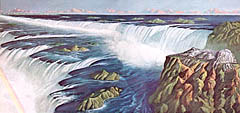
|
The Cataract of Hercules, once located between the Pillars of Hercules.
The Glomar Challenger
expedition proved that parts of the Mediterranean basin had once been dry desert, above sea level. This 10-mile-wide channel between the Mediterranean and the Atlantic, now routinely used by shipping, had once hosted a massive waterfall that drained Osiria's River Styx (now "The Nile") into the Atlantic. This waterfall was reversed by the Great Flood, and became the channel through which the tsunami that accompanied the Great Flood washed through and inundated the lowlying areas of the Osirian Empire. This channel remains today as the primary source of water for the Mediterranean Sea, without which it would quickly dry up.
Image from
National Geographic.
|

This vast, fertile valley punctuated by large, freshwater lakes that sat at the heart of the Osirian Empire was, in the dim memory of human history, largely submerged by a sudden, catastrophic deluge that most equate with the Great Flood mentioned in the Bible. Noted author Graham Hancock, who has exhaustively researched the theory of a now-submerged antediluvian civilization in his classic treatise,
Underworld, explains it thusly:
Descriptions of a killer global flood that inundated the inhabited lands of the world turn up everywhere amongst the myths of antiquity. In many cases these myths clearly hint that the deluge swept away an advanced civilization that had somehow angered the gods, sparing "none but the unlettered and the uncultured" and obliging the survivors to "begin again like children in complete ignorance of what happened ... in early times." Such stories turn up in Vedic India, in the pre-Columbian Americas, in ancient Egypt. They were told by the Sumerians, the Babylonians, the Greeks, the Arabs and the Jews. They were repeated in China and southeast Asia, in prehistoric northern Europe and across the Pacific. Almost universally, where truly ancient traditions have been preserved, even amongst mountain peoples and desert nomads, vivid descriptions have been passed down of global floods in which the majority of mankind perished.12
This "Great Flood" that swept over the entire Earth was accompanied by massive tsunami that washed over even the high places of Osiria, tossing even the massive stones of its megalithic temples around like matchsticks. There is definitive proof that one or more massive tidal waves had washed over the islands of Malta in ancient times, utterly sweeping away all but the heaviest objects, and seriously damaging or destroying even the massive megalithic temples of antediluvian Osiria in the process. It was this rush of water that some, who believe Noah had once lived in Osiria, rode into the next age. Childress explains,
Sections measuring thousands of cubic miles of water hit the earth on the land between Pantelleria and Gibraltar, while other great sections hit between Malta and Palestine and small sections merely hundreds of cubic miles hit the Upper Rhone. The effect of that blow was to scoop out the two Mediterraneans, for the water had a terrific motion from west to east which would have swamped every ship on the ocean and would have swamped Noah but that his ship had been built some thousands of feet above sea level.... All this destruction caused by a colossal wave rushing from west to east can be witnessed in the stone age megalithic ruins of Hagar Qim. When one examines these ruins closely, one will easily see that the wall facing directly westwards has been completely destroyed. This wall, which had to bear the brunt of this gigantic wave followed by the rush of the water in its wake could not withstand the onslaught, no matter how massive it had been. According to the other remaining outer walls it must have been very massive. Huge blocks of stone from the western wall have been blown off from their original position and piled up in a heap some ten meters away towards the east as if they had been so many wooden boxes and not blocks of stone almost a meter square and about 3 meters along.... Certainly no earth tremor or strong wind could throw such heavy stones to such distances and all in the same direction ... only a gigantic wave of water from the west could reasonably explain these movements.13
Even the high places of Osiria on the peaks of the mountains were not spared the waters of the Great Flood, though their shattered ruins remain today to show us that there was indeed a world before the Flood, a world that was megalithic in stature.
Though there were probably numerous megalithic structures of lesser importance in ancient Osiria, the most important were situated at the top of the highest peaks. And since Malta is not only one of the highest peaks that survived the flood, but also the one with the densest population of archaeological artifacts, it stands to reason that it was the most important religious and political center of its time.
I say religious and political, as religion and politics at that time were not separated. In our ancient past, the gods of the state were also the rulers of the state, and their priesthoods ruled their lands for them. Also, as numerous ancient cart tracks all over the island attest, Malta was probably also the economic capitol of Osiria, as the majority of the massive amounts of produce brought in for sacrifices to the goddess were sold back to the populace at a profit. Moreover, the priestesses likely had to christen ("Isen"?) new children, as well as perform marriages and funerals and other social functions typically performed by religious leaders in society, making ancient Malta the social capitol as well. Thus, antediluvian Malta was likely the religious, social, economic and political center of the Osirian Empire.
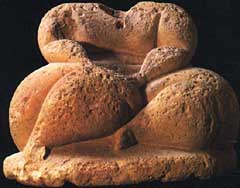
|
The "fat lady" or "Venus of Malta" came in many forms, all grossly obese, indicating a person of immense proportions. Some have
argued that the fat lady is actually an androgynous being, pointing out that there are no specific sexual characteristics, whereas
others point out
examples
of the fat lady where sexual characteristics are present. Still others believe that the fat lady was meant to
represent the fertile, abundant earth, and sexual identity was not an issue. However, most tend towards the idea that the "fat lady"
sat at the center of an ancient matriarchal culture, and was the progenitor of the concept of what we now call
"Mother Earth".
Image from
The OTS Foundation.
|
Our search for the 14 lost pieces of Osiris starts, then, on Malta. But where on Malta? There are numerous archaeological sites all over the island. However, the largest and probably best-known ruins are those of
Hagar Qim, which are also the best preserved. Hagar Qim, lit.,
"erect stones", is made up of several chambers, including an "oracle room", and several altars. It was there that
nineteenth-century archaeologists found the now famous "fat lady" statues, an ancient fertility figure more commonly known
as "the Venus of Malta". Based upon this and other discoveries about the religious nature of the monument, it is believed
that Malta lay at the center of an ancient matriarchal civilization that worshipped a mother goddess.
Hagar Qim and the
other structures were in fact temples where this mother goddess — who was essentially an embodiment of the fertility
of the land — was worshipped. Moreover, the still-visible ruts of the numerous ancient tracks created by countless
carts criss-cross the entire island, some of which are nearly two feet deep. The quantity of tracks on the island makes it
clear that the temples once lay at the center of a vast agrarian empire — much larger than the current island of Malta.
The numerous cart ruts point to massive amounts of produce being carted into the area from surrounding regions, which makes
sense as the temple in ancient times was, besides being
the center of religious belief, also the center of commerce. Interestingly, the tracks do not end at the edge of the cliffs
that overlook Malta's many beaches, but continue on for some distance into the surrounding ocean, proving that, at the time
when Malta's temples were in use, the sea level was significantly lower — or, as we have seen, non-existent in this region.
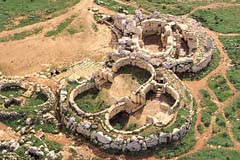
|
The Gigantija Temple, seen from above. Gigantija was so named as the legends surrounding the temple said that the stones were so huge,
the walls so high, and the complex so massive, it could only have been built by giants. Note the curved walls, imitating the ample
curves of the "fat lady".
Image from
The OTS Foundation.
|
Though Hagar Qim is perhaps the most famous and well-preserved of the monuments, the oldest and largest may actually be
Ggantija
on the nearby island of Gozo. Ggantija, lit., "belonging to the giants", was so named by the Maltese because they
believed the huge, megalithic stones used to build the monument could only have been lifted by giants. Some of the walls
are as much as 18 feet tall, and very thick, and contain niches and shrines which make it clear that Ggantija, like Hagar
Qim was also once a temple. Interestingly, the Maltese do have a tradition of giants on the islands, particularly Gozo. One
story,
"The Giantess of Qala",
talks about a giant woman who lived on the island of Gozo who was able to lift and carry around very heavy rocks. The story
appears to describe how some of the monuments were built, though the story might simply be a fabrication created by
imaginative islanders to explain the giant "fat lady" statues and the huge rocks that are literally all over the island. However, as
we saw in this issue's story on
Giants,
giants were considered a historical reality not only by the Bible, but numerous other related traditions. If so, the stories about giants building these ancient structures might be true. These ancient master masons may have left their mark all over the ancient world, and Osiris may have been the greatest of these ancient "mighty men" of old.
This ancient, peaceful culture, however, met a sudden and violent end, as evidenced by the fact that many of these massive stones have been uprooted and thrown dozens of feet — a feat that would have required forces of incredible magnitude. This was caused by the Great Flood mentioned in the Bible and numerous related legends all over the world, including ancient Athens. Let us look now upon Plato's account of ancient Athens, and its role in the antediluvian "war to end all wars" that raged right up to the time that the waters of the Great Flood covered the entire Earth.

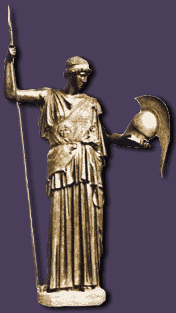
|
In
Part I
of our series on Atlantis, we discussed Plato's
Timaeus
and
Critias,
ancient Greek poems that contain the famous story of the war between Atlantis and ancient Athens. These poems, set around 600 b.c., relate the story of how one Solon, an important government official from Athens, had visited Egypt with the purpose of initiating a cultural exchange between the two peoples. To his surprise, Solon learned from an Egyptian priest that the Egyptians and the Athenians were once one people, but had been physically separated by a Great Flood that had destroyed all but a handful of the Athenians, the barrier between them being, apparently, a newly formed "Mediterranean Sea". This flood had left Egypt relatively unscathed, however, and so whereas the Athenian Greek culture had been destroyed and its accumulated knowledge lost, the Egyptian culture had remained intact enough so that the tradition of the Flood was not forgotten.
Critias contains similar information to Timaeus regarding the war between ancient Athens and Atlantis, but it includes more details about Athens, about its lands and its people, including the fact that Athens and Greece used to occupy a much larger area before a series of floods wiped out much of the lands and sank them into the Mediterranean.
However, though Athens existed as a powerful nation around 600 b.c., it actually had its origins well before that time, around 10,000 b.c. or even earlier. This is because the story conveyed in Timaeus and Critias was actually set not during the time of Solon, but some 9000 years before that time — around 9600 b.c., near the end of the last Ice Age. It was the time when the gods were on Earth, breeding and guiding the various races of humanity that had been allotted to them, preparing them for a final battle that would decide who would rule Earth. And of the Olympian gods of Greece, to Athena and her half-brother Hephaestus, were given the Athenians.
In the days of old the gods had the whole earth distributed among them by allotment.... They all of them by just apportionment obtained what they wanted, and peopled their own districts; and when they had peopled them they tended us, their nurselings and possessions, as shepherds tend their flocks, excepting only that they did not use blows or bodily force, as shepherds do, but governed us like pilots from the stern of the vessel, which is an easy way of guiding animals, holding our souls by the rudder of persuasion according to their own pleasure;-thus did they guide all mortal creatures.
Now different gods had their allotments in different places which they set in order. Hephaestus and Athene, who were brother and sister, and sprang from the same father, having a common nature, and being united also in the love of philosophy and art, both obtained as their common portion this land, which was naturally adapted for wisdom and virtue; and there they implanted brave children of the soil, and put into their minds the order of government; their names are preserved, but their actions have disappeared by reason of the destruction of those who received the tradition, and the lapse of ages.14
The gods of the Athenians were
Hephaestus, the god of fire, crafts, and the forge, and
Athena,
goddess of war, as well as of the city, handicrafts, and agriculture.
There are interesting parallels between the myths of the Greeks and the myths of the Egyptians, particularly the myth of Osiris.
Horus,
the son of Isis and Osiris was, like Hephaestus, born with stunted legs. Other interesting Greek/Egyptian religous parallel exists between
the birth of Athena and the birth of the Egyptian gods
Shu
and
Tefnut,
where all were born directly from a male god, Athena from Zeus and Shu and Tefnut from
Ptah,
no woman being involved in the birth of either. Could this be support for the opinion that the god/goddess of Malta was actually androgynous, a self-completed human being — capable of self-reproduction — that some have argued was the true deity of Malta and, by extension, ancient Osiria? Athena, her virginity being one of her prime attributes, displays both male and female characteristics, which may point to the fact that ancient Osiria was not only matriarchal in nature, but androgynous.
Athens, according to the Egyptian priests was once a much larger area, but was greatly reduced down to its present size by a series of inundations, some of which might have occurred in historic times.
Concerning the country the Egyptian priests said what is not only probable but manifestly true, that the boundaries were in those days fixed by the Isthmus, and that in the direction of the continent they extended as far as the heights of Cithaeron and Parnes; the boundary line came down in the direction of the sea, having the district of Oropus on the right, and with the river Asopus as the limit on the left. The land was the best in the world, and was therefore able in those days to support a vast army, raised from the surrounding people. Even the remnant of Attica which now exists may compare with any region in the world for the variety and excellence of its fruits and the suitableness of its pastures to every sort of animal, which proves what I am saying; but in those days the country was fair as now and yielded far more abundant produce.
How shall I establish my words? and what part of it can be truly called a remnant of the land that then was? The whole country is only a long promontory extending far into the sea away from the rest of the continent, while the surrounding basin of the sea is everywhere deep in the neighbourhood of the shore. Many great deluges have taken place during the nine thousand years, for that is the number of years which have elapsed since the time of which I am speaking; and during all this time and through so many changes, there has never been any considerable accumulation of the soil coming down from the mountains, as in other places, but the earth has fallen away all round and sunk out of sight.
The consequence is, that in comparison of what then was, there are remaining only the bones of the wasted body, as they may be called, as in the case of small islands, all the richer and softer parts of the soil having fallen away, and the mere skeleton of the land being left. But in the primitive state of the country, its mountains were high hills covered with soil, and the plains, as they are termed by us, of Phelleus were full of rich earth, and there was abundance of wood in the mountains.15
This vast, rich, fertile plain had not been supported by solid rock, so when the floods came, the land was washed away, and only that land that lay upon solid bedrock and mountainous areas was kept from sliding into the sea. The Egyptian priest recalled the fact that several major deluges had taken place before and since the Great Flood came 9,000 years previously, as well as other cataclysms of mysterious origin, all of which collectively had kept the Athenians continually struggling to survive.
There have been, and will be again, many destructions of mankind arising out of many causes; the greatest have been brought about by the agencies of fire and water, and other lesser ones by innumerable other causes. There is a story, which even you have preserved, that once upon a time Paethon, the son of Helios, having yoked the steeds in his father's chariot, because he was not able to drive them in the path of his father, burnt up all that was upon the earth, and was himself destroyed by a thunderbolt. Now this has the form of a myth, but really signifies a declination of the bodies moving in the heavens around the earth, and a great conflagration of things upon the earth, which recurs after long intervals; at such times those who live upon the mountains and in dry and lofty places are more liable to destruction than those who dwell by rivers or on the seashore. And from this calamity the Nile, who is our never-failing saviour, delivers and preserves us.
When, on the other hand, the gods purge the earth with a deluge of water, the survivors in your country are herdsmen and shepherds who dwell on the mountains, but those who, like you, live in cities are carried by the rivers into the sea. Whereas in this land, neither then nor at any other time, does the water come down from above on the fields, having always a tendency to come up from below; for which reason the traditions preserved here are the most ancient. The fact is, that wherever the extremity of winter frost or of summer does not prevent, mankind exist, sometimes in greater, sometimes in lesser numbers. And whatever happened either in your country or in ours, or in any other region of which we are informed-if there were any actions noble or great or in any other way remarkable, they have all been written down by us of old, and are preserved in our temples.
Whereas just when you and other nations are beginning to be provided with letters and the other requisites of civilized life, after the usual interval, the stream from heaven, like a pestilence, comes pouring down, and leaves only those of you who are destitute of letters and education; and so you have to begin all over again like children, and know nothing of what happened in ancient times, either among us or among yourselves.16
Before the Great Flood, however, the Athenians were known to be the best fighters in the world, having proven themselves in combat against the mighty Atlantean armies that had threatened to enslave Europe, Africa, Asia, and "all who dwelt between the pillars":
As for those genealogies of yours which you just now recounted to us, Solon, they are no better than the tales of children.
In the first place you remember a single deluge only, but there were many previous ones; in the next place, you do not know that there formerly dwelt in your land the fairest and noblest race of men which ever lived, and that you and your whole city are descended from a small seed or remnant of them which survived. And this was unknown to you, because, for many generations, the survivors of that destruction died, leaving no written word. For there was a time, Solon, before the great deluge of all, when the city which now is Athens was first in war and in every way the best governed of all cities, is said to have performed the noblest deeds and to have had the fairest constitution of any of which tradition tells, under the face of heaven.17

As was recounted in the Bible, just before the Great Flood, Earth was "filled with violence", meaning the entire Earth was at war. As we saw in
Part II
of our Atlantis series, and in
Part I
of Giants in the Earth, the Nephilim giants of old were engaging in a massive world war with each other to see who would rule the world. Since both the Atlanteans and the Athenians were specially bred by gods who had "come down from heaven" in order to rule over the men in their appointed districts, and both Atlas and Athena were warlike deities, giving their peoples gifts of technology and teaching them how to make war, it stands to reason that these two peoples would inevitably come into conflict with each other. Also likely is the fact that the Atlanteans and the Athenians had been genetically modified by their respective deities so that they would be more effective in war, which meant they were made larger, stronger, and fiercer — giants. In the case of the giants of Athens/Osiria, it would appear that at least some were androgynous in nature, as is evidenced by Athena and the "Venus of Malta", both of whom were gigantic in stature. This was a war of annihilation, a war to see who would rule the world, forever:
Many great and wonderful deeds are recorded of your state in our histories. But one of them exceeds all the rest in greatness and valour. For these histories tell of a mighty power which unprovoked made an expedition against the whole of Europe and Asia, and to which your city put an end. This power came forth out of the Atlantic Ocean, for in those days the Atlantic was navigable; and there was an island situated in front of the straits which are by you called the Pillars of Heracles; the island was larger than Libya and Asia put together, and was the way to other islands, and from these you might pass to the whole of the opposite continent which surrounded the true ocean; for this sea which is within the Straits of Heracles is only a harbour, having a narrow entrance, but that other is a real sea, and the surrounding land may be most truly called a boundless continent.
Now in this island of Atlantis there was a great and wonderful empire which had rule over the whole island and several others, and over parts of the continent, and, furthermore, the men of Atlantis had subjected the parts of Libya within the columns of Heracles as far as Egypt, and of Europe as far as Tyrrhenia. This vast power, gathered into one, endeavoured to subdue at a blow our country and yours and the whole of the region within the straits; and then, Solon, your country shone forth, in the excellence of her virtue and strength, among all mankind. She was pre-eminent in courage and military skill, and was the leader of the Hellenes. And when the rest fell off from her, being compelled to stand alone, after having undergone the very extremity of danger, she defeated and triumphed over the invaders, and preserved from slavery those who were not yet subjugated, and generously liberated all the rest of us who dwell within the pillars.
But afterwards there occurred violent earthquakes and floods; and in a single day and night of misfortune all your warlike men in a body sank into the earth, and the island of Atlantis in like manner disappeared in the depths of the sea.18
The Athenians had successfully repelled the Atlantean assault upon Osiria, though the rest of their allies who had lived in the region — the proto-Egyptians and the rest of the antediluvian peoples — had failed them. Escaping enslavement to the Atlanteans, however, they were destroyed by a massive flood that had breached the pillars and flooded the entire Mediterranean basin, and possibly more. All that remains today is a relative handful of megalithic remains, with more under the surface, waiting to be found by the next generation of intrepid explorers.

The search for the ancient Osirian Empire — and for the 14 lost pieces of Osiris — starts on the island of Malta. Long a favorite tourist destination for Europeans, Malta is fast becoming a world-class premiere tourist destination not only for its megalithic architecture, but for its other historic features, such as the Templar castles and other remnants of the age of chivalry, as well as its top-flight restaurants, entertainment, and accomodations. Ancient secrets may lie waiting to be uncovered, both above ground and below water (though only experienced divers should attempt any underwater archaeology). For more information on your Malta vacation, contact
VisitMalta.com.
Become a part of the legend! Send us your tales of your search for the 14 lost pieces of Osiris, and you may have your story published in future issues of Mysterious World! 
Part II: Antediluvian Egypt
|
Part III: Nimrod Hunting
|
Part IV: The Beast from the Sea
The Land of Osiris
|
Malta: Capitol of Osiria?
|
The Athenian Empire
|
The Search for Osiris
Osiria Links
|
Osiria Books
|
Osiria Audio
|
Osiria DVD
Editorial
|
Press Releases
|
Book Reviews
|
Fragments
Serpent Mound I
|
Giants I
|
Osiria I
Register
for our new Hall of Records Newsletter!
Questions? Comments? Suggestions? Advertising? Press Releases?
Contact us!

1
David Hatcher Childress,
Lost Cities of Atlantis, Ancient Europe & the Mediterranean
(Stelle, IL: Adventures Unlimited Press, 1996), 30.
2
Childress,
Lost Cities of Atlantis, Ancient Europe & the Mediterranean, 27.
3
April McDevitt,
"OSIRIS (Asar, Wesir, Ausar, Unnefer)" (Ancient Egypt: The Mythology: http://www.egyptianmyths.net). The word "Egyptian" is actually also a Greek corruption — the Egyptians actually referred to themselves as being from the land of "Khemet". This is confirmed by the Bible, as this name is very similar to the name of Ham, son of Noah, from whom the Egyptians were said to have descended.
4
TourEgypt.net,
"Osiris, Asar" (TourEgypt.net: http://www.touregypt.net).
5
April McDevitt,
"OSIRIS (Asar, Wesir, Ausar, Unnefer)" (Ancient Egypt: The Mythology: http://www.egyptianmyths.net).
6
McDevitt,
"The Story of Isis and Osiris" (Ancient Egypt: The Mythology: http://www.egyptianmyths.net).
7
Mike Ward and Chris Ward,
"Osiris" (University of Colorado: Social Science Data Lab: http://sobek.colorado.edu/LAB/GODS/index.html).
8
Childress,
Lost Cities of Atlantis, Ancient Europe & the Mediterranean, 29.
9
Samuel W. Matthews,
"This Changing Earth",
National Geographic
Vol. 143, No. 1, (January 1973): 20-21.
Cf. also Kenneth J. Hsu,
The Mediterranean Was a Desert: A Voyage of the Glomar Challenger (Princeton: Princeton University Press, 1983).
10
Childress,
Lost Cities of Atlantis, Ancient Europe & the Mediterranean, 205.
11
Childress,
Lost Cities of Atlantis, Ancient Europe & the Mediterranean, 205.
12
Graham Hancock,
Underworld (New York: Crown Publishers, 2002), 20.
13
Childress,
Lost Cities of Atlantis, Ancient Europe & the Mediterranean, 206.
14
Plato,
"Critias: Page 2",
(The Active Mind: http://www.activemind.com).
15
Plato,
"Critias: Page 3",
(The Active Mind: http://www.activemind.com).
16
Plato,
"Timaeus: Page 2",
(The Active Mind: http://www.activemind.com).
17
Plato,
"Timaeus: Page 2",
(The Active Mind: http://www.activemind.com).
18
Plato,
"Timaeus: Page 2",
(The Active Mind: http://www.activemind.com).




 Plato: Timaeus & Critias
Plato: Timaeus & Critias
 University of Iowa: Briefing on Lost Continents
University of Iowa: Briefing on Lost Continents
 Washington State University: The Athenian Empire
Washington State University: The Athenian Empire
 Heritage Malta
Heritage Malta

 Malta's Prediluvian Culture at the Stone-Age Temples
Malta's Prediluvian Culture at the Stone-Age Temples
 MaltaVista
MaltaVista
 The Megalithic Temples of Malta
The Megalithic Temples of Malta
 The Megalithic Temples of Malta: Map
The Megalithic Temples of Malta: Map
 Mysterious Malta
Mysterious Malta
 The Planning and Layout of the Maltese Neolithic Temples
The Planning and Layout of the Maltese Neolithic Temples
 OTS Foundation: The Temples of Malta
OTS Foundation: The Temples of Malta
 Hagar Qim Temples
Hagar Qim Temples
 The Megalithic Temples of the Maltese Islands: Hagar Qim Temple
The Megalithic Temples of the Maltese Islands: Hagar Qim Temple
 Ggantija Temple
Ggantija Temple
 Edrichton.com: The Neolithic Temples of Malta
Edrichton.com: The Neolithic Temples of Malta
 Discovering the Ancient Mother in Malta
Discovering the Ancient Mother in Malta
 Hospitallers of St. John of Jerusalem
Hospitallers of St. John of Jerusalem
 World Atlas: Malta
World Atlas: Malta
 OTS Foundation: Visiting Malta
OTS Foundation: Visiting Malta
 Lonely Planet: Malta
Lonely Planet: Malta
 Sydney Morning Herald: Malta
Sydney Morning Herald: Malta
 EuroTravelling.net: Malta
EuroTravelling.net: Malta
 VisitMalta.com
VisitMalta.com
 VisitMalta.com: How to Get There
VisitMalta.com: How to Get There
 Malta Direct Travel
Malta Direct Travel
 Maltours
Maltours
 SelectMalta.com
SelectMalta.com
 Pilgrim Tours: Malta
Pilgrim Tours: Malta
 Goddess Tours to Malta
Goddess Tours to Malta
 0800 Malta
0800 Malta
 Budget Travel: Malta
Budget Travel: Malta
 Columbus World Travel Guide: Malta
Columbus World Travel Guide: Malta
 Travel Malta
Travel Malta
 Dream Malta
Dream Malta
 Le Meridien Phoenicia
Le Meridien Phoenicia
 U.S. State Dept.: Malta Travel Info
U.S. State Dept.: Malta Travel Info
 Malta Tourist Photos
Malta Tourist Photos
 maltaNET Internet Services
maltaNET Internet Services
 Kinnie - Malta's Own Favorite Soft Drink
Kinnie - Malta's Own Favorite Soft Drink

 The Lost City of Atlantis: The Island of Thera
The Lost City of Atlantis: The Island of Thera
 Santorini and the Legend of Atlantis
Santorini and the Legend of Atlantis
 Atlantis.....Thira?
Atlantis.....Thira?
 Was Plato's Atlantis a Memory of Minoan Civilization?
Was Plato's Atlantis a Memory of Minoan Civilization?
 The Tsunami Page: "The Waves That Destroyed the Minoan Empire (Atlantis)"
The Tsunami Page: "The Waves That Destroyed the Minoan Empire (Atlantis)"
 GreekIslands.com: Crete
GreekIslands.com: Crete
 Explore Crete
Explore Crete

 Atlantis Discovered: Thesis
Atlantis Discovered: Thesis
 Sardinia.net
Sardinia.net
 In Italy Online: Welcome to Sardinia!
In Italy Online: Welcome to Sardinia!
 Discover Sardinia
Discover Sardinia
 ItaliaTour! Sardinia
ItaliaTour! Sardinia
 ItaliaTour! Atlantis Bay (Sicily)
ItaliaTour! Atlantis Bay (Sicily)
 Atlantis Charter
Atlantis Charter
 Corsica Ferries/Sardinia Ferries
Corsica Ferries/Sardinia Ferries
 Sardinia Climb
Sardinia Climb

 University of Colorado: Osiris
University of Colorado: Osiris
 EgyptianMyths.net: Osiris
EgyptianMyths.net: Osiris
 EgyptianMyths.net: The Story of Isis and Osiris
EgyptianMyths.net: The Story of Isis and Osiris
 TourEgypt.net: Osiris, Asar
TourEgypt.net: Osiris, Asar
 Ohio State University: Osiris
Ohio State University: Osiris
 EgyptianMyths.net: Horus
EgyptianMyths.net: Horus
 EgyptianMyths.net: Shu
EgyptianMyths.net: Shu
 EgyptianMyths.net: Tefnut
EgyptianMyths.net: Tefnut
 EgyptianMyths.net: Ptah
EgyptianMyths.net: Ptah
 Mythweb: Hephaestus
Mythweb: Hephaestus
 The goddess Athena: Athena
The goddess Athena: Athena

 TravelPiriReis.com
TravelPiriReis.com
 Atlantis Resort
Atlantis Resort
 BlueAegean.com: Atlantis
BlueAegean.com: Atlantis
 TourEgypt.net
TourEgypt.net
 The Rock of Gibraltar
The Rock of Gibraltar
 Gibraltar Rock Tours
Gibraltar Rock Tours
 1 Gibraltar Plaza
1 Gibraltar Plaza
 Choosing Cruising: Morocco
Choosing Cruising: Morocco
 Travel Notes: Morocco
Travel Notes: Morocco


 Lost Cities of Atlantis Ancient Europe & the Mediterranean
Lost Cities of Atlantis Ancient Europe & the Mediterranean
(Lost Cities Series)
David Hatcher Childress
Rating:    
One of Childress' popular "Lost Cities" series, Lost Cities of Atlantis Ancient Europe & the Mediterranean covers the region in and around the Mediterranean Sea, with a special emphasis on cities and mysteries submerged beneath the waters of this vast inland sea. Calling himself a "maverick archaeologist", Childress is more of a researcher, historian, travel writer, and general raconteur rather than a a true academic archaeologist, making general observations based upon library research, study of local myths, legends, and personal anecdotes, as well as actual experiences visiting these sites. Childress is part of a growing trend in historical and archaeological studies towards the rise of independent researchers. These independents are men and women who have developed a distrust for "mainstream" academic archaeology, due to the fact that there is increasing evidence that the academic community is dismissing, ignoring, or even suppressing archaeological evidence that does not fit in with their preset theories. As a result, these independents have dismissed academe as largely irrelevant, and have gone out on their own to examine the evidence for themselves, usually at their own time and expense. It was this kind of passionate search for the truth about history and our origins that motivated similar men of the 19th century to develop the science of archaeology, a passion that motivated people of the 20th century like Childress, unsatisfied by the condescending, pat answers of academics, to take matters into their own hands. Now, in the 21st century, a growing chorus of discontentment with the academic archaeological establishment continues to erode their viselike grip on the truth of our origins, and the independents stand poised to wrest the sword of truth from the hands of those who seem only to be concerned about personal power, privilege, and social status. Lost Cities of Atlantis, Ancient Europe & the Mediterranean is a fascinating read, and a good addition to the Lost Cities series. It should make a great traveling companion for anyone traveling in the Mediterranean region, as well as a cracking great read for the armchair archaeologist, or just someone who enjoys ancient history and mysteries.
Click
here
to buy this book.
 Underworld: The Mysterious Origins of Civilization
Underworld: The Mysterious Origins of Civilization
Graham Hancock
Rating:     
From the author of the bestselling Fingerprints of the Gods comes a fascinating voyage of underwater discovery that will forever change the way we think about the birth of civilization. Fans of
The Sign and the Seal
and
Heaven�s Mirror
will delight in Graham Hancock�s Underworld, his latest work of archaeological detection. In this mesmerizing book, Hancock merges cutting-edge science with historical myth to come up with a new explanation for the origins of civilization as we know it today. At the end of the last Ice Age melting ice caused sea levels around the world to rise by approximately 400 feet, radically changing the shape of the world. Hancock, steeped in the ancient flood myths that speak of early civilizations, sets out to discover whether these myths have any basis in reality. Using the latest computerized "inundation maps" that show the shape of the world�s coastlines as they looked at intervals throughout the meltdown, Hancock finds astonishing correspondences with the ancient flood myths. And, when he starts to explore these areas underwater on several diving expeditions, he actually discovers ruins beneath the sea exactly where the myths say they should be. Hancock offers dramatic accounts of his explorations of the waters of the Arabian Sea, the Mediterranean, and the sea of Japan. This entertaining and provocative book of discovery presents the first hard evidence of these ancient cities, and gives all of us stunning insight into the origins and development of civilization.
(Review by Amazon.com)
Click
here
to buy this book.
 Timaeus and Critias (Penguin Classics)
Timaeus and Critias (Penguin Classics)
Plato, H.D. Lee (Editor)
The complete text of Plato's Timaeus and Critias dialogues. Always the best place to start for any would-be Atlantean (or Osirian) researcher.
Click
here
to buy this book.
 The Egyptian Book of the Dead: The Book of Going Forth by Day
The Egyptian Book of the Dead: The Book of Going Forth by Day
The Book of the Dead is a collection of writings that were placed in tombs as a means of guiding the ancient Egyptian soul on its journey to the afterlife. The Papyrus of Ani, which is reproduced here, is one of the most important and beautiful of the surviving papyri. Damage in the 19th century seriously confused its sequencing and the relationship between text and illustrations. Here for the first time the scroll is presented in its proper sequence and in its entirety. The English text is placed immediately underneath the corresponding hieroglyphs, and the reproductions are faithful to the originals in all their glowing color. A critical purchase for any serious collection of materials on ancient Egypt.
Click
here
to buy this book.
 The Mediterranean Was a Desert: A Voyage of the Glomar Challenger
The Mediterranean Was a Desert: A Voyage of the Glomar Challenger
Kenneth J. Hsu
Rating:    
For those interested in science, earth sciences or plate tectonics, "The Mediterranean Was a Desert" delivers. The book gives an objective account of one of the most important Glomar Challenger voyages. It gives a nice build-up to the discovery, made over the course of that summer voyage, that the Mediterranean had once virtually dried up. The author is a scientist and focuses on aspects of the science and underplays human relationships although some conflicts and human interactions are mentioned. I most enjoyed the descriptions of the way the Mediterranean Sea had been some 4 or 5 million years earlier, the progression of changes, and the evidence which brought him to this viewpoint and why. I least enjoyed the book's style which sounded a bit too much like it had been written by an average scientist rather than a Carl Sagan scientist. Still, it is a worthy read.
Click
here
to buy this book.

|
|
Lonely Planet Malta
Neil Wilson
Whether you're interested in ancient temples or five-day feasts, water sports or basking on beaches, this brand new guide is jam-packed with advice on the best Malta has to offer.
 30 detailed city and regional maps
30 detailed city and regional maps
 illustrated feature on the Knights of St John
illustrated feature on the Knights of St John
 top swimming spots
top swimming spots
 an insider's guide to Maltese food, from quick pastizzi to quality seafood
helpful language guide and glossary
an insider's guide to Maltese food, from quick pastizzi to quality seafood
helpful language guide and glossary
Click
here
to buy this book.
Malta & Gozo Map
Nils Robert Meyer
Road map with contour lines, ferry routes, and distance markers in kilometres. Features: beaches, airports, anchorages, icons for places of interest, natural features, gardens, and populated areas. Scale: 1:50,000.
Click
here
to buy this book.

 Beauty in the Beast
Beauty in the Beast
Wendy Carlos
Rating:     
From the roar of Tibetan horns and the clangor of metal percussion that opens Beauty in the Beast, Wendy Carlos in 1986 signaled a new direction for her music. Beauty in the Beast is Carlos's magnum opus, an album that should have established the synthesizer's role in the new global music landscape. More than that, it should have established Carlos as a composer and not just a Switched-on Bach jukebox. But not too many people were listening. Rereleased now after 14 years, Beauty in the Beast has lost none of its power. Carlos is both profound and poignant, dissonant and disarming on Beauty, as she fuses a global orchestra from her synthesizers. "Poem for Bali" is the centerpiece of the album, an episodic, 17-minute excursion as Carlos orchestrates the sounds and rhythms of a digital gamelan orchestra. In addition to replicating the metallophones, gongs, and flutes of the traditional gamelan, she creates her own hybrid sound designs, giving this work a surreal and sometimes harrowing tone, like a dream bent through funhouse mirrors. But then there are pieces such as "A Woman's Song," based on a Balkan melody. The title track merges nightmare landscapes and a crazed carnival calliope with a haunting theme that sounds like a lament for the end of the world. Beauty in the Beast is an essential recording of both modern composition and synthesis--Carlos should plug into this circuit again.
Click
here
to buy this book.
 Gladiator: Music from the Motion Picture
Gladiator: Music from the Motion Picture
Hans Zimmer, Lisa Gerrard
Rating:     
Most modern Hollywood films have musical "temp tracks" laid in as they're edited, usually classical standards or music from other soundtracks that helps shape the dramatic and emotional intentions of works in progress. Sometimes these temp tracks become the score (as in "2001"), but more often they serve as a template for the film's eventual scorer. That said, we'll boldly climb out on a limb and opine that director Ridley Scott was listening to a whole lot of Holst's The Planets as he was cobbling together his modern gladiator epic. Credit Hans Zimmer for taking "Mars, the Bringer of War" and hammering its familiar harmonic and rhythmic Sturm und Drang into something serviceably fresh; cohort Lisa Gerrard generally handles the more ethereal, atmospheric passages. As epic in scope as its thematic inspiration (and with enough occasional nods to "authenticity" to make it work), this is nonetheless a work of often surprising nuances, and one that recasts the traditional heroic orchestral score in deliciously dark and ominous tones. Warning: repeated listening may inspire the invasion of neighboring countries.
Click
here
to buy this book.
 More Music from the Motion Picture Gladiator
More Music from the Motion Picture Gladiator
Hans Zimmer, Lisa Gerrard
Rating:     
If there's one thing film producers and record executives like more than Success, it's Success: Part 2. Thus when Ridley Scott's high-tech sword 'n' sandal epic scored both Golden Globe wins and Academy Award nods for Best Film and Best Score, it was a sure bet that another volume of Hans Zimmer's and Lisa Gerrard's music for the film couldn't be far behind. Though not exactly leftovers, the tracks here sometimes point to the fact that there wasn't enough fresh material to fill this volume out, hence we get some remixed cues, a handful of familiar music with dramatic dialog excerpts edited and superimposed (or misplaced, with decidedly mixed results), and even a beat-heavy, dance-club mix of "Now We Are Free." With a little over half an hour of entirely fresh material and some souvenir dialog snippets over the rest, there's enough here to please Gladiator die-hards. Also of note: guitarist Heitor Pereira's flamenco-flavored flourishes are better showcased throughout; and "The Gladiator Waltz" serves up one of Zimmer's original synth demos (with a dash of Russell Crowe dialog up front)--a dramatic amp-up of Holst's "Mars, the Bringer of War" that's a prime example of the composer's state-of-the-art digital orchestral conjuring.
Click
here
to buy this book.

 Helen of Troy (2003)
Helen of Troy (2003)
Rating:    
One of the most epic adventure stories of all time comes powerfully to life in this original four-hour epic-series. Filmed in exotic locales with an international cast and featuring state-of-the-art special effects, Helen of Troy depicts one of the greatest battles ever fought to win the love of the world's most beautiful woman. Though married to Menelaus, King of Sparta, Helen (Sienna Guillory) falls madly in love with Paris (Matthew Marsden) a handsome Trojan prince. Together, the lovers flee to Troy, where they are given safe haven by Paris' father, King Priam (John Rhys-Davies). Bent on bringing Helen back, the king's ruthless brother Agememnon (Rufus Sewell) leads the skilled Spartan army to the shores of the fabled city. There the Greeks lay siege to Troy, thus beginning one of history's most legendary wars which would ultimately decide the destinies of two empires.
Click
here
to buy this DVD.
Ancient Civilizations: Athens and Ancient Greece (2002)
This is a very enjoyable DVD which is both travelogue and history. It covers not only Athens, but Delphi, Corinth, Olympia, Sparta, Mycenae and other cities of ancient Greece. The viewer is taken to the modern locations of these ancient places and provided with a wealth of information. The real plus for this video however, is the use of graphical reconstructions for each location or monument mentioned -- and the reconstruction is superimposed on its modern ruin. This is a marvelous way to get a sense of the glory of Greek architecture and a sense of place, especially when only a few ruins remain. You won't get a detailed history of ancient Hellas and some of the pronunciations used are eccentric (e.g., the narrator pronounces Zeus as "zay oos"), but it's worth adding to your collection.
Click
here
to buy this DVD.
Editorial
|
Press Releases
|
Book Reviews
|
Fragments
Serpent Mound I
|
Giants I
|
Osiria I
Register
for our new Hall of Records Newsletter!
Questions? Comments? Suggestions? Advertising? Press Releases?
Contact us!
|

